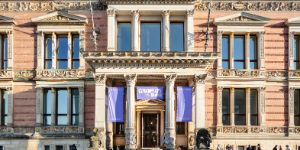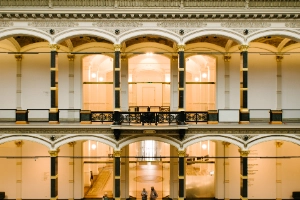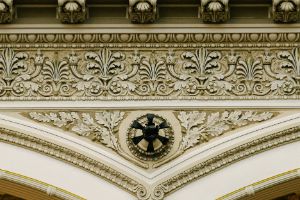
Exterior view, Gropius Bau © Gropius Bau, photo: Luca Girardini
About the Gropius Bau
Located in the centre of Berlin, the Gropius Bau is a lively place to encounter art and each other. The internationally renowned institution stages large-scale exhibitions and performances by contemporary artists. Its diverse events focus on exchange and discussion, bringing together local and global perspectives.
Here, artists shape the programme from within, not only showing their own work, but developing thematic or solo exhibitions of work by other artists. In some cases, they spend several years working in one of the Gropius Bau’s on-site studios, becoming deeply intertwined with the institution and shaping it with their ideas and vision.
In all of this, the notion of playing serves as a proposition for how we can engage with one another in times of increasing social tension: openly rather than judgmentally, with each other rather than against each other and playfully exchanging perspectives and positions. This idea also lies at the heart of BAUBAU, a play space for kids developed by artist Kerstin Brätsch and accessible free of charge. Here, kids are invited to take up space, make noise, let off steam and constantly reinvent a space where more is allowed than forbidden.

Gropius Bau, Atrium
© Gropius Bau, photo: Robert Rieger
History of the Gropius Bau
Designed by architects Martin Gropius and Heino Schmieden as a Museum and School of Decorative Arts, the building opened to the public in 1881. In its dual function as an educational institution and museum, it housed classrooms and studios as well as collections of European crafts and an art library.
During the Second World War the building was badly damaged during air raids on Berlin. The roof and collection holdings in the basement were reduced to ashes; the northern facade and upper floors were almost completely destroyed. The ruins were left to decay until the 1960s, when the planned demolition was averted by the great nephew of its creator, architect and Bauhaus founder Walter Gropius. In 1966, the building was granted protected status under the name Martin-Gropius-Bau, before reconstruction work began in 1978 under architects Winnetou Kampmann and Ute Weström. The aim was to preserve the historical substance and traces of history as well as meet the demands of a modern exhibition venue. At the Gropius Bau today reconstructed mosaics, reliefs and majolica can be found alongside intentionally exposed gaps that attest to the building’s destruction.
For the reopening the entrance had to be relocated to the south side given the building’s then proximity to the Berlin Wall; today’s main entrance on Niederkirchnerstraße was not reopened until 1999. The Gropius Bau has been part of the Berliner Festspiele since 2001.

Gropius Bau, Atrium (detail)
© Gropius Bau, photo: Robert Rieger